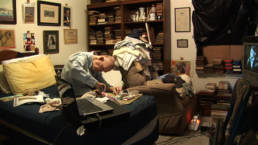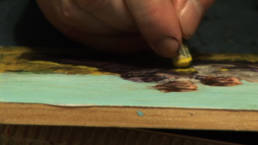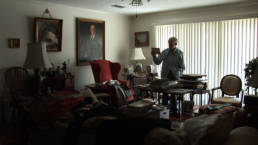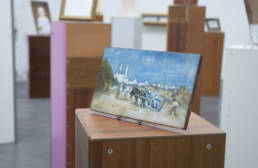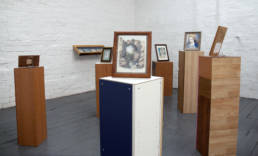Proposal for a Collection
2011
30 paintings and drawings by Mark Landis, 1 video (25 mins), recycled furniture
This project centred around Mark Landis, an exposed counterfeiter who lives in Laurel, Mississippi. Landis had been forging works by Victorian-era American and European artists, as well as folk and colonial art, since the mid 1980s. When he had perfected a work, he adopted an alter-ego – most commonly a Jesuit priest called Father Scott – and donated it to a museum. Then he would disappear.
In the mid 2000s, he began to arouse suspicion. During their initial meetings with him, museum curators forgave him his peculiar nature, merely seeing him as a wealthy eccentric not unlike many of their other patrons/donors. However, they began to spot the works as fakes fairly quickly after he had gone, and would attempt to contact him, only to find that the details he’d given were false. As he began to leave a increasingly substantial trail, the press began to report him as a mysterious character, before The Art Newspaper finally published an exposé in December 2010. The New York Times followed up the story, reporting it to a wider audience the following January.
A journalist from The Financial Times, John Gapper, tracked Landis down to his home address and attempted to interview him about his exposure. However, after a short discussion, Gapper became aware that Landis did not know he had been exposed, as he does not read The Art Newspaper or The New York Times. Through Gapper, I got in touch with Mark and visited him in March 2011. When I got there, he was still reeling in the wake of what he called “the scandal,” and feared that what had essentially been his reason for being had been taken away from him. Unlike most forgers, he wasn’t driven by money or bitterness, and he had no desire to unmask the artworld as a sham, he simply saw himself as a philanthropist without financial means.
Before Gapper’s visit, Landis had been planning another so-called “binge”, whereby he would produce a large body of work, fill the boot of his Cadillac, and drive around the southern US States dropping into museums and galleries to donate pictures to their collections. The pictures were copied from the Sotheby’s and Christie’s catalogues to which he subscribed, and were chosen to reflect the tastes of his parents; meaning that over three decades he’d essentially been generating an imaginary family collection. When he learned that word had got out, he stopped work and cancelled his trip, leaving twenty to thirty objects in various states of completion and with nowhere to go.
I spent three days in Laurel making a film of Landis producing a version of Charles Courtney Curran’s 1894 work, Three Women (the picture that had been widely reported as the one that contributed most to his downfall), in which he explains his working method and makes occasional observations on his situation. He also explained that he had no use for the pictures he was working on, and gave them to me to bring back to Scotland.
Proposal for a Collection was an installation at The Glue Factory in Glasgow, which consisted of thirty paintings and drawings made by Landis displayed on plinths and in cabinets that I made from recycled domestic materials, and the video of Landis making the Curran. This is the last body of work Mark made before he knew it was over, and represents the closest one might be able to get to imagining his output as a collection in itself.
Following the exhibition, and with Landis’ permission, I attempted to donate his pictures to two major UK collections. I met with curators and acquisition panels, and told the full story of the objects and how they came into my possession. The offer was rejected on both occasions. The experience of this rejection led me to write an essay, From Art Objects to Art Things (2016) and then to curate an exhibition, The Landis Museum (2018). Through these two further sites, I developed a new reading of Landis’ work, as well as an (albeit temporary) museum dedicated to his activities and bearing the family name.
I have also produced two additional works, The Memory Trick and Lot 114, Sotheby’s (London), 30 November 1994 with Landis.
Exhibited in:
Proposal for a Collection
The Glue Factory, Glasgow (8 June 2011 → 18 June 2011)
